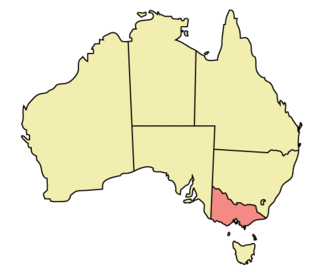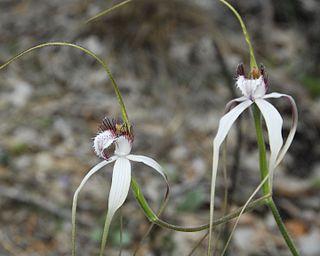
Caladenia longicauda is a species of plant in the orchid family Orchidaceae and is endemic to the south-west of Western Australia. It is distinguished by its large leaf and by its up to five large, white flowers which have drooping sepals and petals with long, thickish brown "tails".

Caladenia dilatata, commonly known as the green-comb spider orchid and as koolin in indigenous language, is a plant in the orchid family Orchidaceae and is endemic to south-eastern Australia. It has a single leaf and a single yellowish-green flower with reddish stripes and occurs in Victoria and Tasmania. It is similar to C. necrophylla which occurs in south-east South Australia and to C. concinna from southern New South Wales.
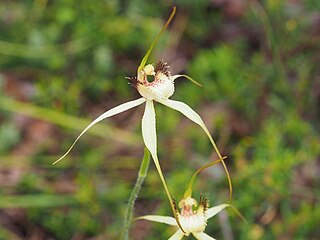
Caladenia busselliana, commonly known as Bussell's spider orchid, is a plant in the orchid family Orchidaceae and is endemic to a small area in the south-west of Western Australia. It is a rare orchid with an erect, hairy leaf and up to three pale yellow flowers. Only about fifty specimens are known and it is threatened by habitat destruction and by too-frequent or too infrequent bushfires.
Caladenia calcicola, commonly known as the Bats Ridges spider orchid, is a plant in the orchid family Orchidaceae and is endemic to a small area near the Victoria - South Australia border. It is a ground orchid with a single hairy leaf and one or two glossy, pale yellow flowers with maroon markings.
Caladenia colorata, commonly known as coloured spider-orchid, small western spider-orchid and painted spider-orchid is a plant in the orchid family Orchidaceae and is endemic to South Australia and possibly Victoria. It is a ground orchid with a single hairy leaf, and usually a single creamy-green flower with blood-red or purple-brown markings and with dark tips on the petals and sepals.

Caladenia formosa, commonly known as the large crimson spider orchid, or elegant spider orchid is a plant in the orchid family Orchidaceae and is endemic to Victoria and South Australia. It is a ground orchid with a single hairy leaf and a single crimson-coloured flower and which mainly occurs only in south-western Victoria.

Caladenia fulva, commonly known as the tawny spider orchid, is a plant in the orchid family Orchidaceae and is endemic to a small area in Victoria. It is a ground orchid with a single hairy leaf and one or two creamy-white to pale yellow flowers. Only two small populations are known, although both are in nature reserves.

Caladenia lowanensis, commonly known as Wimmera spider orchid is a plant in the orchid family Orchidaceae and is endemic to Victoria. It is a ground orchid with a single leaf and a single cream-coloured flower with red lines and blotches. The total population of this orchid was estimated in 2010 to be only about 700 plants but most are protected in reserves.

Caladenia oenochila, commonly known as the red-lipped spider orchid, or wine-lipped spider orchid, is a plant in the orchid family Orchidaceae and is endemic to Victoria. It is a ground orchid with a single leaf and usually only one pale yellow-green flower with purple marks and a dark red labellum.

Caladenia parva is a plant in the orchid family Orchidaceae and is endemic to south-eastern Australia. It is a ground orchid with a single leaf and one or two green flowers with red stripes along the sepals and petals.
Caladenia peisleyi is a plant in the orchid family Orchidaceae and is endemic to south-eastern Australia. It is a ground orchid with a single leaf and a single greenish-yellow flower with pale red stripes. It is difficult to distinguish from several other Caladenia species.

Caladenia phaeoclavia, commonly known as the brown-clubbed spider orchid is a species of orchid endemic to New South Wales. It has a single, hairy leaf and a single light to dark green flower with red stripes and thick, brownish club-like tips on the sepals.
Caladenia pumila, commonly known as the dwarf spider orchid is a plant in the orchid family Orchidaceae and is endemic to Victoria. It is a ground orchid with a single erect, hairy leaf and a single white flower with pale pink stripes. Its short flowering stem distinguishes it from other Victorian spider orchids. After 1933 it was presumed extinct until two plants were discovered in 2009.

Caladenia verrucosa, commonly known as the mallee spider orchid, is a plant in the orchid family Orchidaceae and is endemic to south-eastern Australia. It is a ground orchid with a single, hairy leaf and usually only one greenish-yellow and red flower.

Caladenia stricta, commonly known as the upright spider orchid or rigid-combed spider-orchid is a plant in the orchid family Orchidaceae and is endemic to southern continental Australia. It is a ground orchid with a single leaf and usually only one pale green flower with red lines along the sepals and petals.
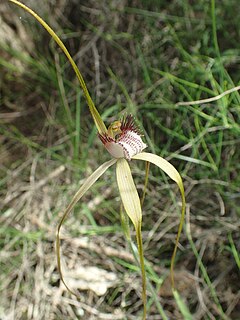
Caladenia swartsiorum, commonly known as the Island Point spider orchid, is a species of orchid endemic to the south-west of Western Australia. It has a single erect, hairy leaf and up to three pale greenish-yellow and white flowers and is only known from a small area near the Harvey Estuary.
Caladenia thysanochila, commonly known as the peninsula spider orchid or fringed spider-orchid, is a plant in the orchid family Orchidaceae and is endemic to Victoria. It is a ground orchid with a single hairy leaf and a single bright white to pale pinkish flower. Only two flowers have been seen and the species is thought to be extinct.
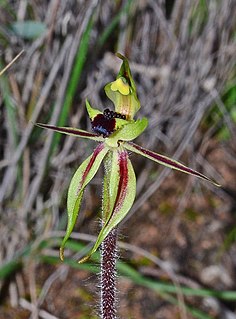
Caladenia toxochila, commonly known as the bow-lip spider orchid is a plant in the orchid family Orchidaceae and is endemic to south-eastern Australia. It is a ground orchid with a single, sparsely hairy leaf and one or two yellowish-green flowers with red stripes. It occurs in Victoria and South Australia and resembles the related Caladenia concinna from New South Wales.
Caladenia validinervia, commonly known as the Lake Muir spider orchid, is a species of orchid endemic to the south-west of Western Australia. It has a single erect, hairy leaf and up to three greenish to creamy white flowers with red stripes on the sepals and petals. The flowers have relatively narrow sepals and petals and a relatively small labellum. It is a rare orchid only known from an area between Rocky Gully and Collie.

Caladenia villosissima, commonly known as the hairy spider orchid, is a plant in the orchid family Orchidaceae and is endemic to Victoria. It is a ground orchid with a single densely hairy leaf and a single pale green flower with red stripes along the sepals and petals. It is a poorly known species and there is insufficient information about its distribution and abundance to determine whether or not it is endangered.















